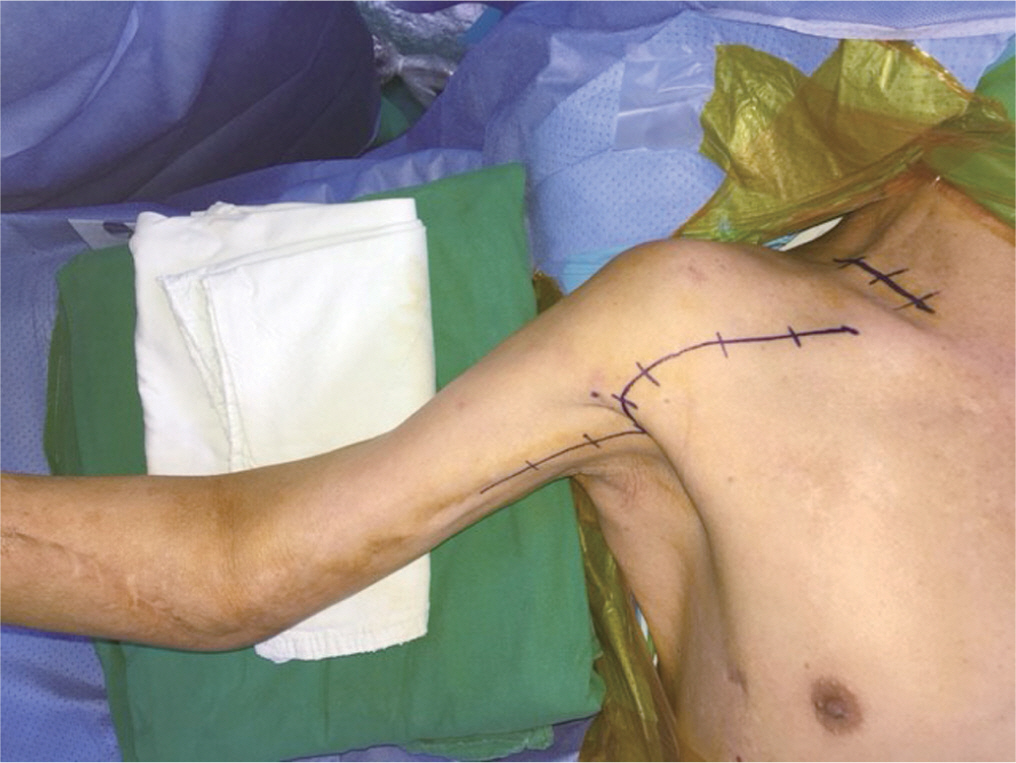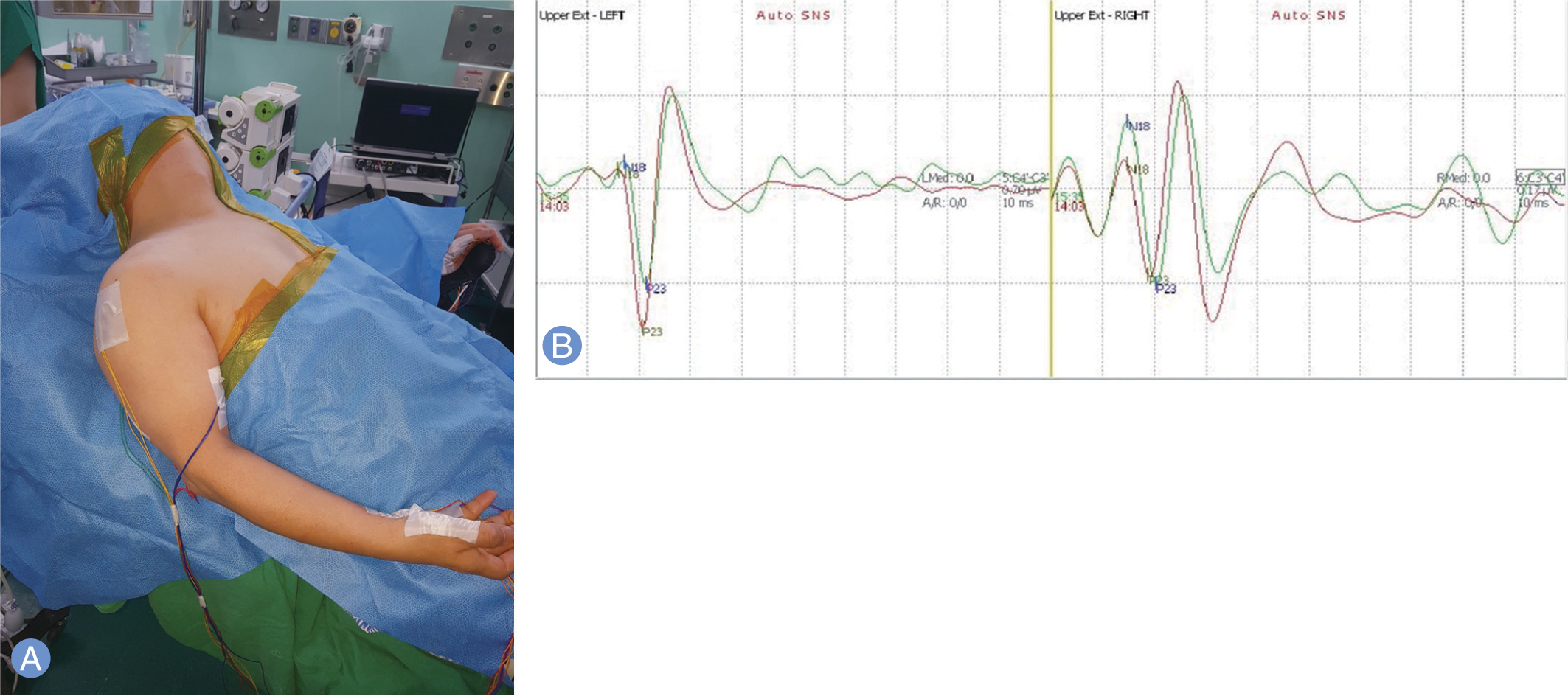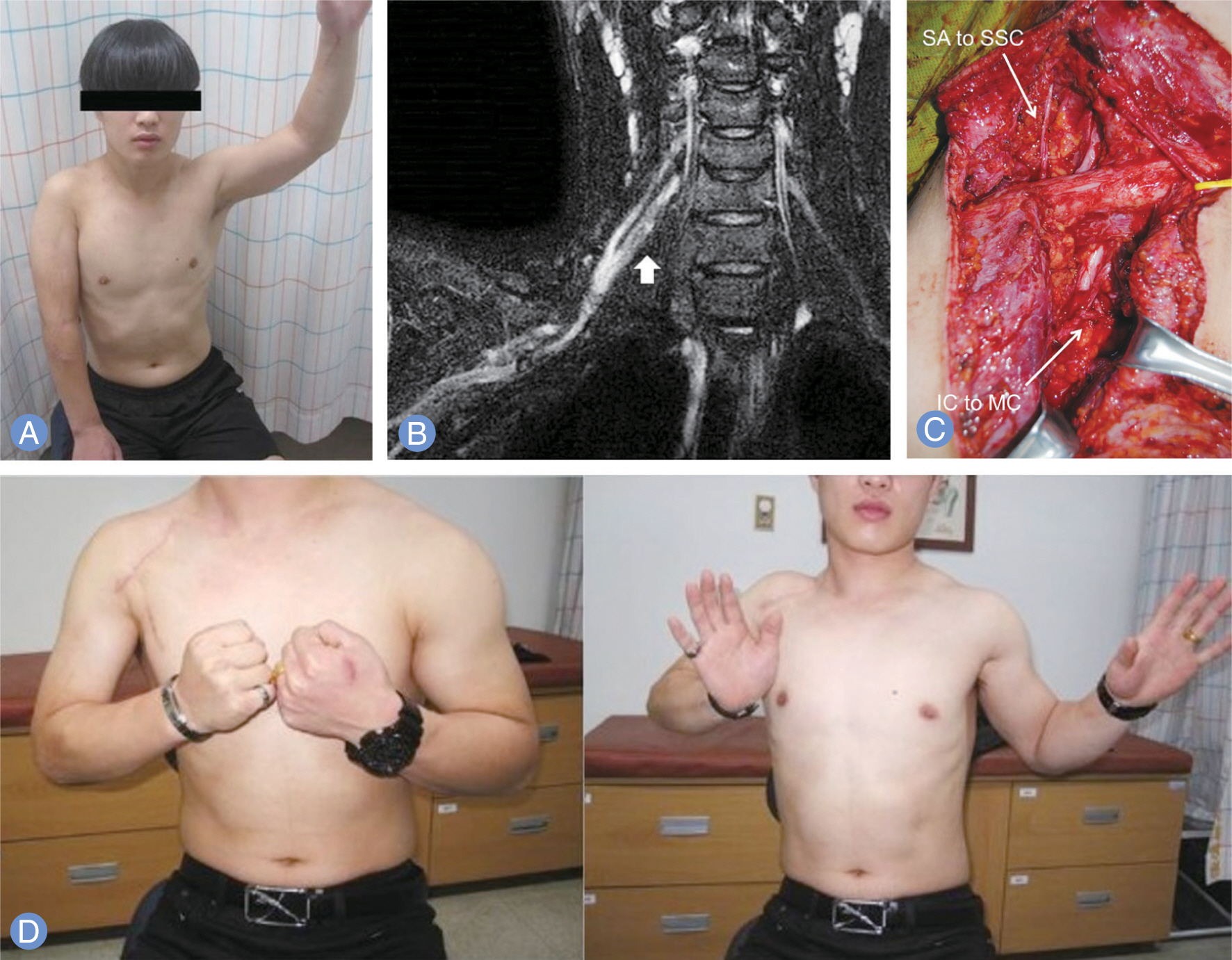J Korean Soc Surg Hand.
2017 Sep;22(3):137-146. 10.12790/jkssh.2017.22.3.137.
Traumatic Brachial Plexus Injury: Preoperative Evaluation and Treatment Principles
- Affiliations
-
- 1Department of Orthopedic Surgery, Dankook University College of Medicine, Cheonan, Korea. kimjp@dankook.ac.kr
- KMID: 2391210
- DOI: http://doi.org/10.12790/jkssh.2017.22.3.137
Abstract
- Brachial plexus injury is regarded as one of the most devastating injuries of the upper extremity. Accurate diagnosis is important to obtain the successful results. Basic preoperative evaluation includes simple radiography, cervical myelography. Magnetic resonance imaging, angiography, electrophysiologic studies and intraoperative studies. Furthermore, proper timing of surgery, surgical indication, plan and sufficient understanding of patients about the prognosis are the key for the satisfactory outcomes. This article provides an overview of the evaluation, diagnosis, intraoperative monitoring, and proper surgical planning for the treatment of posttraumatic brachial plexus injuries.
Keyword
MeSH Terms
Figure
Reference
-
References
1. Bonney G. Prognosis in traction lesions of the brachial plexus. J Bone Joint Surg Br. 1959; 41:4–35.
Article2. Brunelli G. Direct neurotization of severely damaged muscles. J Hand Surg Am. 1982; 7:572–9.
Article3. Hentz VR, Narakas A. The results of microneurosurgical reconstruction in complete brachial plexus palsy: assessing outcome and predicting results. Orthop Clin North Am. 1988; 19:107–14.
Article4. Kawai H, Kawabata H, Masada K, et al. Nerve repairs for traumatic brachial plexus palsy with root avulsion. Clin Orthop Relat Res. 1988; (237):75–86.
Article5. Songcharoen P, Shin AY. Brachial plexus injury: acute diagnosis and treatment. Berger RA, Weiss AP, editors. Hand surgery. Philadelphia: Lippincott Williams & Wilkins;2004; 1005–25.6. Limthongthang R, Bachoura A, Songcharoen P, Osterman AL. Adult brachial plexus injury: evaluation and management. Orthop Clin North Am. 2013; 44:591–603.7. Robert EG, Happel LT, Kline DG. Intraoperative nerve action potential recordings: technical considerations, problems, and pitfalls. Neurosurgery. 2009; 65(4 Suppl):A97–104.8. Kline DG. Timing for brachial plexus injury: a personal experience. Neurosurg Clin N Am. 2009; 20:24–6.
Article9. Narakas AO. The treatment of brachial plexus injuries. Int Orthop. 1985; 9:29–36.
Article10. Hentz VR, Doi K. Traumatic brachial plexus injury. Wolfe S, Pederson W, Hotchkiss R, Kozin S, editors. Green’s operative hand surgery. Philadelphia: Elsevier;2010; 1235–94.11. Mansat M. Surgical topographic anatomy of the brachial plexus. Rev Chir Orthop Reparatrice Appar Mot. 1977; 63:20–6.12. Nagano A, Ochiai N, Sugioka H, Hara T, Tsuyama N. Usefulness of myelography in brachial plexus injuries. J Hand Surg Br. 1989; 14:59–64.
Article13. Doi K. Management of total paralysis of the brachial plexus by the double free-muscle transfer technique. J Hand Surg Eur Vol. 2008; 33:240–51.14. Amrami KK, Port JD. Imaging the brachial plexus. Hand Clin. 2005; 21:25–37.
Article15. Harper CM. Preoperative and intraoperative electrophysiologic assessment of brachial plexus injuries. Hand Clin. 2005; 21:39–46.
Article16. Kobayashi J, Mackinnon SE, Watanabe O, et al. The effect of duration of muscle denervation on functional recovery in the rat model. Muscle Nerve. 1997; 20:858–66.
Article17. Songcharoen P, Mahaisavariya B, Chotigavanich C. Spinal accessory neurotization for restoration of elbow flexion in avulsion injuries of the brachial plexus. J Hand Surg Am. 1996; 21:387–90.
Article18. Coulet B, Boretto JG, Lazerges C, Chammas M. A comparison of intercostal and partial ulnar nerve transfers in restoring elbow flexion following upper brachial plexus injury (C5-C6+/-C7). J Hand Surg Am. 2010; 35:1297–303.
Article19. Mackinnon SE, Novak CB, Myckatyn TM, Tung TH. Results of reinnervation of the biceps and brachialis muscles with a double fascicular transfer for elbow flexion. J Hand Surg Am. 2005; 30:978–85.
Article20. Liverneaux PA, Diaz LC, Beaulieu JY, Durand S, Oberlin C. Preliminary results of double nerve transfer to restore elbow flexion in upper type brachial plexus palsies. Plast Reconstr Surg. 2006; 117:915–9.
Article21. Chuang ML, Chuang DC, Lin IF, Vintch JR, Ker JJ, Tsao TC. Ventilation and exercise performance after phrenic nerve and multiple intercostal nerve transfers for avulsed brachial plexus injury. Chest. 2005; 128:3434–9.
Article22. Bertelli JA, Ghizoni MF. Reconstruction of complete palsies of the adult brachial plexus by root grafting using long grafts and nerve transfers to target nerves. J Hand Surg Am. 2010; 35:1640–6.
Article23. Malungpaishrope K, Leechavengvongs S, Witoonchart K, Uerpairojkit C, Boonyalapa A, Janesaksrisakul D. Simultaneous intercostal nerve transfers to deltoid and triceps muscle through the posterior approach. J Hand Surg Am. 2012; 37:677–82.
Article
- Full Text Links
- Actions
-
Cited
- CITED
-
- Close
- Share
- Similar articles
-
- Steroid Injection into the Compartment of the Brachial Plexus in a Pediatric Patient with Traumatic Brachial Plexus Injury: A case report
- Spinal Cord Stimulation in a Patient with Preganglionic and Postganglionic Brachial Plexus Injury: A case report
- The Diagnostic Value of MRI in Traumatic Brachial Plexus Injury
- MR Imaging of Traumatic Brachial Plexus Injury
- A Case of Traumatic Meningocele by Brachial Plexus Avulsion







